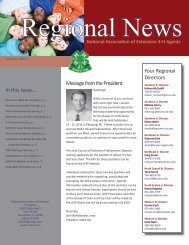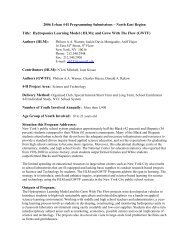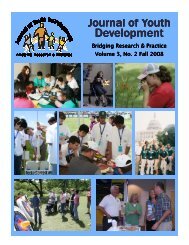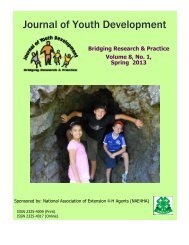Winter 2008 - Vol. 3 No. 3 - National Association of Extension 4-H ...
Winter 2008 - Vol. 3 No. 3 - National Association of Extension 4-H ...
Winter 2008 - Vol. 3 No. 3 - National Association of Extension 4-H ...
- No tags were found...
Create successful ePaper yourself
Turn your PDF publications into a flip-book with our unique Google optimized e-Paper software.
Healthy Families was then <strong>of</strong>fered as a class to all interested families through the communitycenter venue without the clinical/medical and home-visitor components. In the communitycenter setting, Healthy Kids, Healthy Families continued to incorporate information on nutrition,physical activity, cognition, self esteem, culture and family dynamics. The program focus wasadapted to explore aspects <strong>of</strong> prevention and program delivery, highlighting activities such assports, family activities, aquatics, and other parks and recreation events.In lieu <strong>of</strong> the contextual changes that included the absence <strong>of</strong> clinical data and physicianreferrals, the method <strong>of</strong> inquiry was adapted to elicit participant experiences through qualitativefocus group findings from an additional 12 families. A focus group method was selected toevaluate the intervention in a community setting. Focus groups were conducted because theyprovide a venue for processing empirical material so as to interpret richness, complexity, andinterpretive processes necessary for researchers to observe the ways in which people interactand construct meanings [around creating healthier lifestyles] (Kamberelis & Dimitriadis, 2005).The focus group questions facilitated discussion on perceptions about family nutrition, physicalintervention activities were discussed. Focus group findings indicated that parents and childrenfound the program to be helpful and were satisfied with how it was <strong>of</strong>fered. However, in thecommunity setting it appeared that without medical referrals, many parents were unclear aboutthe purpose <strong>of</strong> the Healthy Kids, Healthy Families group.Satisfaction with the Intervention• It helped enhance social skills.“I think it was helpful for her. I think it socially was very good for her.”• Working on communication and self-esteem was important.“I know it did help in make (child) feel more important to her mother, she’s not as clingyto mommy at home now.”• Children expressed multiple ways that their families can help them be healthy: providehealthy foods, not allowing them to eat junk food, being physically active with them,and telling them how they are special.Satisfaction with the Process• Many parents were unclear about the purpose <strong>of</strong> the group.“I really had no idea really for sure, but I thought it was going to be something more <strong>of</strong>a type <strong>of</strong> a counseling thing for the kids.”• Most parents did not think that the program needed any modifications.“Probably nothing. I thought it was really good, the way you presented everything and,made it really understandable for the kids and probably for some adults too, you know.”Areas for Further StudyEfforts are underway to secure Healthy Kids, Healthy Families programs in their current venuesand to investigate the possibility <strong>of</strong> expanding the program to additional counties. We will als<strong>of</strong>acilitate additional community center focus groups during the upcoming year to determineparticipant and county staff perceptions <strong>of</strong> the program. Focus group data will help modify theprogram to better address the issues facing families with overweight children such as socialsupport, motivation and readiness to change.






